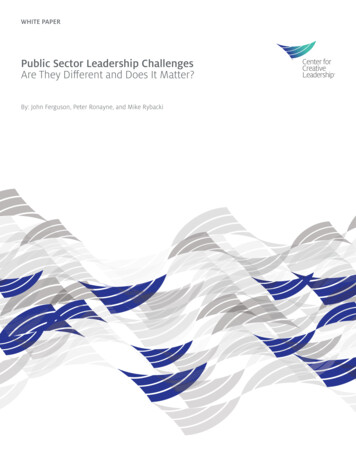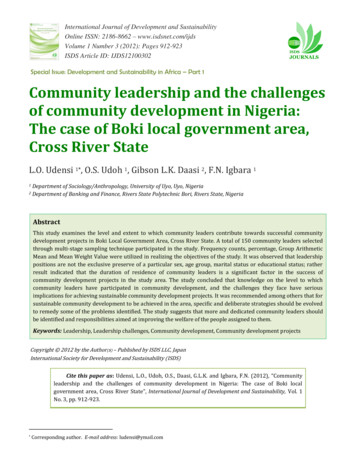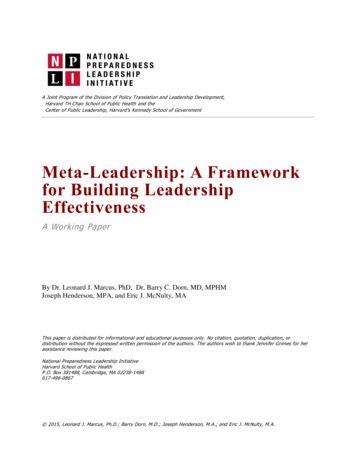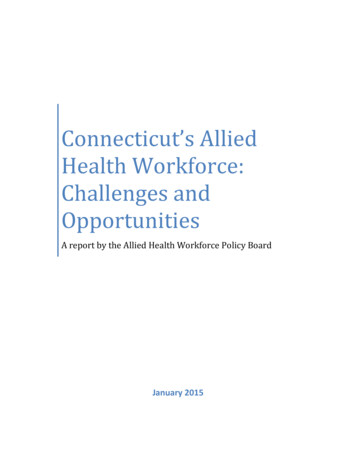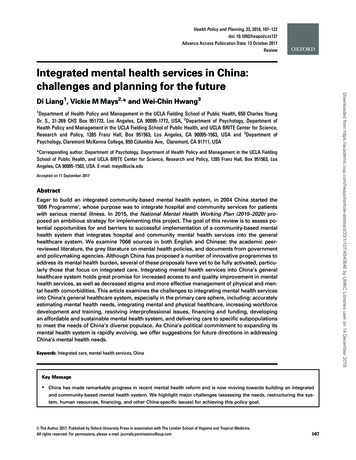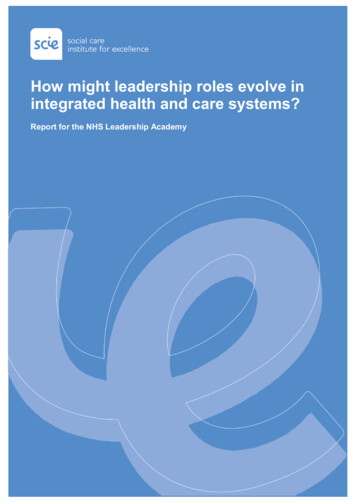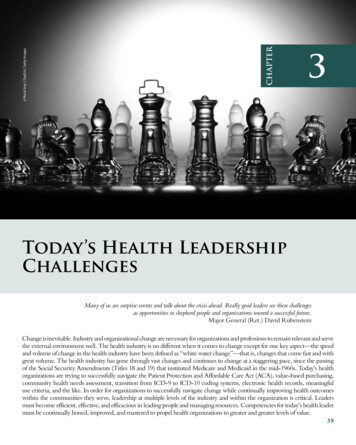
Transcription
CHapTer Murat Inan / EyeEm/ Getty Images.3Today’s Health LeadershipChallengesMany of us see surprise events and talk about the crisis ahead. Really good leaders see these challengesas opportunities to shepherd people and organizations toward a successful future.Major General (Ret.) David RubensteinChange is inevitable. Industry and organizational change are necessary for organizations and professions to remain relevant and servethe external environment well. The health industry is no different when it comes to change except for one key aspect—the speedand volume of change in the health industry have been defined as “white water change”—that is, changes that come fast and withgreat volume. The health industry has gone through vast changes and continues to change at a staggering pace, since the passingof the Social Security Amendments (Titles 18 and 19) that instituted Medicare and Medicaid in the mid-1960s. Today’s healthorganizations are trying to successfully navigate the Patient Protection and Affordable Care Act (ACA), value-based purchasing,community health needs assessment, transition from ICD-9 to ICD-10 coding systems, electronic health records, meaningfuluse criteria, and the like. In order for organizations to successfully navigate change while continually improving health outcomeswithin the communities they serve, leadership at multiple levels of the industry and within the organization is critical. Leadersmust become efficient, effective, and efficacious in leading people and managing resources. Competencies for today’s health leadermust be continually honed, improved, and mastered to propel health organizations to greater and greater levels of value.39
40Chapter 3: Today’s Health Leadership ChallengesLeArNiNg OBJeCTiVeS1. Outline why the dynamic forces within the industry are important to professionals in the health industry, and identifychallenges that require quality leadership intervention strategies.2. Explain and give an example of one aspect of change in the industry today, and link the leadership competencies thatare necessary for successfully navigating the organizational changes required to deal with this change.3. Relate, discuss, and explain the importance of the application of a leadership competency model to contemporaryhealth industry change.4. Distinguish the different aspects or domains of change in the health industry and how those domains impact leadership capability, and explain how the synergy of those changes impacts leadership capability and organizationalsuccess.5. Relate the health reform efforts of the past decade to leadership needs at the health organization level.6. Evaluate the health industry’s needs for leadership today and into the next decade.InTroDuCTIonThere are a multitude of challenges facing the healthorganization leader today. This chapter will serve as anintroduction for the concepts that we will revisit throughoutour discussions of leadership for health professionals. Twocontributing authors, Drs. William Mase and Dave Schott,collaborated with Drs. Ledlow and Stephens on thischapter; Drs. Mase and Schott are professionally trainedin public health policy. Because the health industry isintegrating public health and healthcare delivery (alongwith shared financial and service risk) it is prudent toattend to the aspects of integration between these two vitalsegments of the industry. This chapter intends to provide aforeshadowing of what health leaders need to understand,be aware of, and strategically and operationally plan for inorder to successfully lead people and manage resources amidthis dynamic turbulence. To support the introduction of thecomplex challenges facing today’s health leaders, we havedeveloped a visual representation of the current situation;this visual representation structures the discussion. Thediscussion is focused on health leadership over the nextdecade.Figure 3-1 illustrates the flow of information and theinterconnected nature of the health leadership competencies and how policy affects and is affected by the variousdomains of healthcare leadership. The second half of thechapter presents major contemporary leadership development and competency domains. These domains arepresented as they relate to the various challenges discussedin the first half of the chapter.poLITICaL InfLuenCePolitical influence is the ability of those wielding thepolitical power to shape and control the political behaviorof others and to lead and guide the behavior of others ina desired direction. Political behavior can include manydifferent activities, all of which are concerned with publicpolicy.1 Because the ultimate purpose of obtaining politicalinfluence is to shape and control public policy, the policies ofan organization or nation will change over time dependingon the views and influence of those with political power.The primary tools by which government officials shape andcontrol public policy are legislation and statutes.LegIsLaTIon anD sTaTuTesLegislation is a law that has been enacted by a governingbody. A statute is the formal written enactment of alegislative authority at any level—city, state, or country.2Legislation and statutes related to health are of greatconcern to healthcare executives because they governnearly every aspect of health care, from reimbursement forprocedures to facility maintenance. Health policy includesthe decisions, plans, and actions that are undertaken toachieve a specific healthcare goal within society. When
The Iron Triangle of Health CareLegislation& emFeedbackQualityStrategic Decision Analytics41HealthSystemAnalyticFramework4 Psof HealthAnalyticsRiskData acDatadHealth Status, Delivery, Policies, BusinessCostStructuresProcessesPublic HealthHealth Care DeliverySociodemographic FactorsResources, Reimbursement, & FundingTechnology & AdvancementsAccessOutcomesEfficacy & Valueof System†Operational Decision SystemaPatient CarebCommunitiescCare Processes and AdministrationdRevenue and CostsFigure 3-1 Today’s health leadership challenges.constructed successfully, health policy can achieve multipleaims. First, it can define a vision for the future, which inturn, helps to establish targets and reference points for theshort and mid-term. Second, it can outline priorities andthe expected roles for different groups and individuals.3Once enacted, health policies are implemented bygovernment agencies. When agencies implement policy,they do so through creation of regulations. Laws do notalways include all of the details needed to explain how anindividual or business must act to follow the law. Therefore,Congress authorizes certain government agencies to createregulations.4 These regulations set specific requirementsregarding what is legal and what is not. For the healthcareindustry, many of the governing regulations are interpreted,“translated into practice,” and put in place and enforced bythe Centers for Medicare and Medicaid Services (CMS).The risks associated with the creation or implementationof new policy can be large. To help describe these risks, aswell as quantify the benefits from policy programs, it is common to use models or theoretical frameworks to describe theprocess. When enacting policy that affects the U.S. healthsystem, there are three main areas that should be impacted bythe policy decision: cost, quality, and access. Theoretically,these three areas are opposed to one other. This oppositionalrelationship is described as the “Iron Triangle” of health care.THe Iron TrIangLe ofHeaLTH CareThe first mention of the Iron Triangle model was in a 1994book by physician William Kissick. The model describesthe relationship between cost, quality, and access to care.In its purest form, the model states that if two of thecomponents move in a positive direction, the third mustmove in a negative direction. For example, when cost andquality increase, access must decrease. Kissick postulatedthis model after reflecting on the major issues within theU.S. healthcare system.Costs include any costs associated with providinghealth care. Total cost includes what is charged to patients,either directly or as an insurance deductible. Quality istypically measured in patient outcomes. Quality care leadsto improved health status for the individual receiving thecare. Access to care is the ease of obtaining care for a patient.
42Chapter 3: Today’s Health Leadership ChallengesFactors that can negatively affect access include the numberof physicians accepting patients, healthcare facilities, andavailability of equipment.The Iron Triangle model has been criticized as notbeing a rigid relationship but instead just a general guideline.5 However, there are still very few instances that“break” the iron triangle relationship. The conditions that“break” the relationship described by Kissick are: Increasing efficiency Decreasing regulation Improving technologyThese situations are the exception rather than the norm.The Iron Triangle model has been used to describe the costincreases that occurred after the passage of the ACA in 2010.6THe DonabeDIan MoDeLPostulated by Avedis Donabedian, a physician at theUniversity of Michigan in 1966, the model provides aframework for examining health services and evaluatingthe quality of care. The purpose of the Donabedian modelis to modify structures and processes in a healthcare deliverynetwork to improve outcomes. According to Donabedian,structures include all factors that can change the context ofcare delivery.7 Processes include every action that takes placeto provide care. Typically this is thought to include allof the clinical steps, such as diagnosis, treatment, patienteducation, and preventive activities. Processes are furthersubdivided into technical and interpersonal processes.Outcomes include the impact of providing health care toindividuals and the communities in which they live. Thisincludes changes to health status, behavior changes, andknowledge changes.The goal of any leadership initiative is positive outcomes for the organization. Drawing conclusions regardingprogram outcomes may require large sample sizes or longtime periods to account for random variation. In an effortto ensure that outcomes and project goals are met, modern programs are data driven. Since 1986, the Joint Commission has worked to create an evaluation system basedon continuous data collection and periodic feedback onspecific performance measures.8 Over time, performancemeasures and standard scores have been developed andare published for the public on affiliated websites, such asthe Centers for Medicare and Medicaid Services HospitalCompare website located at tml). Value is a main focus of theefforts in these areas. What is valuable to the communitythat you serve?DIsrupTIve InnovaTIonDisruptive innovation is a hot topic in health care today. Atthe American College of Healthcare Executives (ACHE)congress in 2016, disruptive innovation took center stagein a discussion regarding the federal goal to tie 20% ofMedicare payments to value and quality through alternativepayment models by the end of the year. This CMS goal isdisruptive to the industry because it is the first time thatexplicit goals for alternative payment models have been setfor Medicare. There are a few leading health systems wellahead of other organizations in this effort. Those leadingsystems have a three-part goal:1. Improve the patient experience of care.2. Improve the health of populations.3. Reduce the cost per capita of health care.9You may notice that these three goals are in direct conflictwith the Iron Triangle relationship we just discussed. Howare these health systems able to achieve these goals? Canchange occur through disruptive innovation?The healthcare industry moves at a rapid pace, andone of the more recent examples of disruptive innovationis robotic and laparoscopic surgery. Prior to laparoscopictechniques a cholecystectomy required a large incision inthe abdomen. Laparoscopic techniques allowed for thelarge incision to be replaced by four much smaller incisions.The net effect was an increased level of safety in the procedure, faster OR turnover, and a decreased length of staywith better patient outcomes. Robotic surgery has furtherexpanded on these benefits.10The demand for these disruptive innovations iscreated by manufacturers, providers, and patients. However, if the learning curve associated with disruptiveinnovation is not managed, unintended consequences ofrapid acceptance may lead to patient harm. When adapting disruptive innovations, it is important to consider allfactors, including potential harm, benefit, and learningcurve management. It has been suggested that one of thebest ways to cope with rapid change and disruptive innovations is using the “manage, steer, and create” model.Under this model, healthcare leaders are encouraged tomanage the present, steer to the next horizon, and createthe future.11 The health leader of the present, and surelyinto the future, will also see a myriad of data-driven and“big data-” driven tools, programs, and solutions that willeither stand alone for utilization of the health organizationor will embed or interface with existing clinical and enterprise resource planning information systems; these will beorganic to the health organization’s information system or
Public Healthexist in an open-architecture or cloud environment. Thesedisruptive innovation software systems will require leadership to evaluate their value and usefulness based on thehealth organization’s strategic and operational plans, mission, values, and goals.pubLIC HeaLTHThe American public health system is charged withproviding assessment, policy development, and assurancefunctions. These three assigned functions are furthersubdivided into the 10 essential services, which include:(1) monitoring health; (2) diagnosing and investigating;(3) informing, educating, and empowering; (4) mobilizingcommunity partners; (5) developing policies; (6) enforcinglaws; (7) linking to provide care; (8) assuring a competentworkforce; (9) evaluating systems; and (10) conductingresearch (Figure 3-2).Public health powers operate at the national level, statelevel, and local level. Through the effective division ofpowers the public health system can carry out the 10 essential services by addressing public health–related concernsat the local level. The primary functions of promoting andprotecting the health of people and the communities inwhich they live is achieved through the effective coordination of all system-mandated activities. Public health is bestdefined as the collection of publicly available healthcarerelated services that seek to address population-levelhealth. These population-level pro-health services canbe seen as complementary to the healthcare delivery systems that function to treat illness at the individual level.While a physician treats individuals with an illness, publichealth professionals seek to prevent people from gettingsick or injured in the first place.13 Typically, this is donethrough changing behavior patterns and promoting wellness. Notable activities of public health include vaccinedevelopment, health education, tracking of disease andenvironmental issues, and developing policy. Public healthorganizations are typically divided into five core areas:biostatistics, epidemiology, community health, environmental health, and health policy and management.Biostatistics is the use of analytical tools to examinedata relating to living organisms. The most visible use ofbiostatistics in health care is the development and analysisof clinical trials for pharmaceuticals. Epidemiology is theASSESSDiagnose& eTSyanm M CompetentWorkforceOPMDevelopPoliciesPOFigure 3-2 CDC training /page1299.html.43LI CYVDEEL
44Chapter 3: Today’s Health Leadership Challengesbranch of public health that deals with the incidence,distribution, and control of disease or other health-relatedfactors. Community health is best known for healtheducation and promotion resulting from the study andimprovement of health characteristics in geographical areas.Environmental health includes monitoring and improvingthe environment outside as well as within facilities. Finally,health policy and management specializes in recommendingand implementing policy as well as managing the programsthat result from policy implementations.The primary goal of the public health system is to improvethe health status within communities through controllingactivities or environmental variables that could lead to adversehealth outcomes. Of course the efforts of public health arenot able to prevent all morbidity, so the ability to delivertertiary care is still necessary. A physician or other licensedmedical professional usually provides hands-on healthcaredelivery either in a stand-alone facility, such as a nonaffiliatedphysician’s office, or through a healthcare organization.HeaLTHCare DeLIveryThe healthcare delivery system in the United States isarguably the most complex system for delivering care in theworld. This complexity results from the fragmented natureof services provided, the large number of organizationsproviding care, and the existence of both private and publicinsurance as well as self-pay.Outside of the United States, most developed countrieshave a single-payer system that is controlled by thegovernment or an agency controlled by the government.These national health plans are typically financed throughtaxes imposed on the population. These systems areoften much less complex because there is either a single(government) payer or government with a self-pay option.Whether in the United States or elsewhere, healthcareorganizations are under increasing pressure to deliver increasedefficiency and greater value and to simultaneously increase thequality of care. These policy and public opinion mandatesare concurrent with the increasing complexity and needs ofpatients, which is forcing delivery of care model reform.14resourCes, reIMburseMenT,anD funDIngIn 2010, U.S. healthcare spending cost about 2.6 trillion.For decades the rate of healthcare spending in the UnitedStates has grown faster than the growth rate of the economyas a whole.Per capita spending on health care in the United Statesis the highest in the world; however, the health outcomesof the citizens are not the best in the world. For example, the United States ranks comparatively low on measures such as infant mortality, life expectancy at birth, andhealthy life expectancy. In 2011, the United States spent 8,508 on health care per person and received an overallranking of 11. The United Kingdom, which ranks 1, spent 3,406 per person.15 It was thought that the enactment ofthe ACA would lead to lower costs; however, this has yet tooccur. In fact, costs continue to rise post ACA—althoughat a rate of about half that of previous years. Sources areconflicted about the cause of the declining rate, but evidence points to the aftereffects of the 2011 recession in theUnited States.16reIMburseMenTIn the United States, when healthcare organizations providecare to insured patients, the healthcare organizations arereimbursed after the fact by insurance companies. Becauseprivate insurance reimbursement rates are determinedthrough direct negotiations with the health system andthe process can differ among insurers, we will focus onMedicare reimbursement to illustrate the process.Hospitals are reimbursed for inpatient Medicare services provided through the Inpatient Prospective Payment System (IPPS). The payment comes in the form ofa per discharge or per case basis for Medicare beneficiarieswith inpatient stays. The claim filed by the hospital needsto include all outpatient diagnostic services as well as anyadmission-related outpatient services provided prior toadmission to the healthcare organization. When patientsare discharged they are assigned diagnosis related groups(DRGs), a classification system that groups similar clinicalconditions and procedures provided during the patient’shospital stay. When assigning the DRG to the Medicarebeneficiary, the hospital uses the principal diagnosis andup to 24 secondary diagnoses, which can be used to listcomorbidities or complications. Based on these diagnosiscodes and other factors, such as gender, age, and dischargedisposition, the DRG is assigned.17 Medicare reviews casessubmitted for reimbursement and pays or rejects claimsbased on published criteria found on the CMS website.Rejected claims can be appealed by healthcare organizations in a series of formal appeals.In addition, bundled pricing, such as that now requiredwith total joint care (such as joint replacement) bundledpricing for Medicare (federal agency responsible is CMS),will change the reimbursement landscape.18 Bundled pricing
Sociodemographic Factorswill facilitate the establishment of narrow networks ofproviders—a few providers in a given geographical area whoare most efficient and have quality patient outcomes—tobe utilized for services by Medicare health insurance plans.Higher cost providers—those that have not reduced supplychain, labor, and other costs to perform procedures—willbe left out of the network. This is important because thecommercial market–that is, health plans that are not Medicareor Medicaid and are usually established with employeebenefits–tends to follow the federal programs of Medicare andMedicaid for pricing and reimbursement. Understanding the“value proposition” in health care is increasingly part of thebusiness of health care and healthcare services.funDIngHealth care in the United States is generally funded fromthree sources, self-pay, private insurance, and governmentinsurance.Individuals typically use self-pay methods for care notcovered by other sources. Credit cards or other genericmeans of borrowing are sometimes used for this purpose,but there are two options available for individuals to save inadvance for self-pay, flexible spending accounts (FSAs) andhealth savings accounts (HSAs).19FSAs are typically offered by employers. They allowemployees to have a certain amount of money deductedfrom their paychecks and deposited into the FSA. Themoney in an FSA can be used to pay for out-of-pockethealthcare expenses. As an incentive to employees themoney deposited into the FSA is not subject to federalincome tax. However, the money in the FSA is usuallyforfeited at the end of the year, so careful planning isrequired on the part of the employee.20HSAs are also used to pay out-of-pocket expenses.Unlike an FSA, HSAs earn interest and the unused balanceis not forfeited at the end of the year. Typically, people whohave health insurance plans that limit their reimbursementsenough to be classified as high deductible are eligible for anHSA.21Currently, about 17% of healthcare costs across theUnited States are funded out-of-pocket. As you mayexpect, charges for individuals are typically higher thanfor insurance companies, because insurance companies areable to negotiate rates based on volume. This can lead toindividuals who pay out-of-pocket receiving extremelylarge bills for health services. In fact, many personalbankruptcies are related to medical expenses. To avoid thisthe ACA requires almost everyone to have some form ofhealth insurance.2245Private insurance is purchased from insurancecompanies, which must be accredited in each state werethey sell their product. Most private insurance is purchasedby businesses as a benefit for employees; premiums aretypically shared by the business and the employee. Becausethe cost of employer-provided health insurance is notconsidered taxable income, it is essentially governmentsubsidized. Individuals may purchase private insurance ontheir own, but these applications are typically evaluatedclosely to identify risks to the insurance company.23In 2010, the private insurance market in the UnitedStates was fundamentally changed by the passage of theACA. The purpose of the ACA is to increase availability,affordability, and use of health insurance in the UnitedStates. One of the primary methods by which the ACAseeks to accomplish this is through the expansion of theprivate insurance market, creating incentives for employersto provide insurance and penalties for individuals whochoose not to purchase insurance. For the purposes of riskpooling and reducing program overhead, the ACA createdinsurance marketplaces within each state. These insurancemarketplaces impose minimum standards for the insuranceplans sold within them, and there are separate marketplacesfor individuals and small businesses.24Government insurance programs include Medicareand Medicaid as well as programs for active military andNative Americans. The Medicare program is designedto provide health insurance to the elderly, disabled, andindividuals requiring dialysis. Medicaid covers individualsliving below a certain level of income and those withcertain disabilities. Approximately 30% of the population iscovered by government insurance or government-providedcare. The ACA increased federal funding for state Medicaidprograms in the short term and expanded eligibility criteria.However, states are not penalized for not complying withthe new criteria, so the total number of individuals whowill enroll in the program is c factors are things such as age, race,ethnicity, languages, as well as income and education.26There is a growing body of research suggesting that thesefactors affect health outcomes, in addition to influencinghow people are viewed by others and how people viewthe world. For the health leader sociodemographic factorscome down to two questions: Do you know who yourhigh-risk patients and high utilizers are? Do you knowprecisely where they live?
46Chapter 3: Today’s Health Leadership ChallengesAccording to Dr. David Nash, in a presentation atthe 2015 ACHE Congress on Healthcare Leadership, thenumber one health predictor in 2015 is your ZIP code. Thisstems from the observation that large disparities in healthcan be found among pockets of population that live shortdistances from each other. A commonly cited example isthe Washington, D.C., area. Babies born in Montgomery,Arlington, or Fairfax counties can expect to live 6 to 7 yearslonger than babies born in Washington, D.C. These countiesare one ZIP code apart—just a few stops on the subway.Observations like this can be used to predict the percentageof patients who share that risk factor and determine strategiesto improve care coordination and delivery.27Basic electronic health record (EHR) systems, however, are not equipped for this kind of data analysis; moreadvanced systems using predictive analytics are needed. Inorder to elevate a health system from basic EHR usage topredictive analytics there are numerous paths and optionswith regard to software. In order to facilitate decision making by the healthcare organization, a model such as the 4Psof Health Analytics can be used to structure the discussionand formulate a plan of action.THe 4 ps of HeaLTHanaLyTICsTo effectively guide and direct their organizations, healthleaders need information. Starting with raw data gatheredfrom various operational, governmental, and othersystems, how do health leaders create an organizationalculture based on knowledge utilization? How do healthleaders take data, place them in context, integrateinformation from multiple domains, take action based onthe information, promote organizational learning fromthose actions, and improve strategies and operations ofthe healthcare organization? With the changes in thehealthcare industry that require closer connections tothe community’s health care, organizations serve thosecommunities with more assumption of risk for the healthstatus of those communities. What model can healthleaders use to achieve a knowledge-based organization?Complicated ideas are often shown as a model. Amodel is a simplified substitute for an event or situationthat is being studied or predicted. Models can be usedin multiple ways. The most common is to describea situation or prescribe a course of action. A descriptivemodel describes how a system should function according tothe model. A prescriptive model shows how to make a systemfunction according to the model. The most useful type ofmodel is a combination of the two concepts, a model thatis both prescriptive and descriptive. Models of this typedescribe how something works and show how to make itwork as described.Due to the complex nature of the health industrythere are many models regarding the operation of healthorganizations. This is true of health analytics—healthinformation for analysis and decision making—becauseit is an exciting, rapidly evolving field, even by healthindustry standards. The implication of change is relevant—the health industry is a dynamic industry. Recent changesfrom healthcare reform, policy changes, and the need todemonstrate value in health services delivery have created anenvironment where new models of health analytics, healthinformation utilization, and health technology are required.The 4 Ps of Health Analytics describes the interconnections between the four major categories of data foundin health organizations: patients, populations, processes,and profitability (called “net margin” for not-for-profit[NFP] organizations). Traditionally, these four types ofinformation have been used separately. When data arenot easily accessed or integrated with other data fromcomplementary domains, they are referred to as beingin an information silo. As computer systems evolved, itbecame possi
challenges that require quality leadership intervention strategies. 2. Explain and give an example of one aspect of change in the industry today, and link the leadership competencies that are necessary for success

